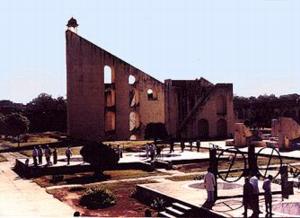
Observatory or "House of Instruments."
The Jantar Mantar or "House of Instruments" at Jaipur is the largest of the observatories built under Maharaja Sawai Jai Singh II. It contains eighteen instruments. They were repaired and reconstructed in 1901.

This photograph shows various instruments placed on platforms. The largest instrument is the Samrat Yantra or equatorial sundial. It consists of a straight ramp or gnomon, about 30 m high, aligned north south and elevated at an angle of 27 degrees above the northern horizon. The latitude of Jaipur is 27 degrees north, thus the ramp points toward the celestial pole. On each side of the ramp there are two quarter circles, or quadrants, fashioned in masonry. The quadrants are centered on the nearest edge of the ramp.

This sketch shows the principle of taking readings from the Samrat Yantra. The Sun casts a shadow of the ramp edge on one of the quadrants; before noon the shadow is cast on the quadrant to the west of the ramp, after noon it is cast on the eastern quadrant. The local solar time can be read from markings on the quadrant at the edge of the shadow. With careful measurements one can measure the local solar time to a precision of a few seconds. One can move a stick up and down the edge of the ramp until the shadow of the stick falls on the appropriate edge of the quadrant. Markings on the ramp can then be read, at the location of the stick, which give the celestial longitude of the Sun. Repeated determination of the longitude of the Sun allows one to determine the time that the Sun crosses the celestial equator and thus the date and time of the equinoxes.
Hartley, C. (2001) 18th Century Observatories of Maharaja Sawai Jai Singh II. Department of Physics, Hartwick College, Oneonta, NY. http://users.hartwick.edu/hartleyc/jantar.htm (accessed 10 March 2004)